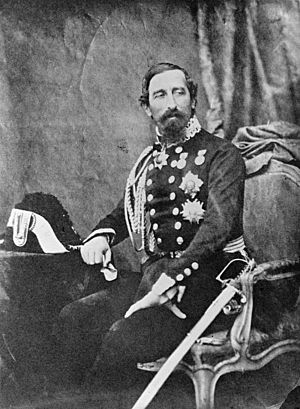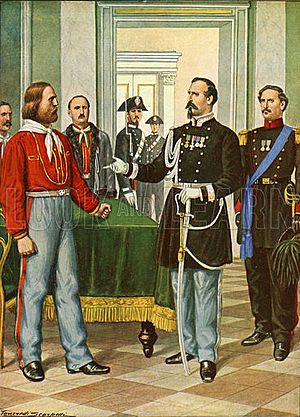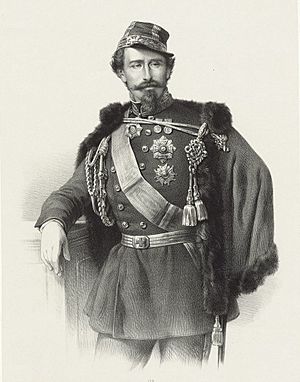Alfonso Ferrero La Marmora facts for kids
Quick facts for kids
Alfonso La Màrmora
|
|
|---|---|
 |
|
| Prime Minister of Italy | |
| In office 28 September 1864 – 20 June 1866 |
|
| Monarch | Victor Emmanuel II |
| Preceded by | Marco Minghetti |
| Succeeded by | Bettino Ricasoli |
| Prime Minister of Sardinia | |
| In office 19 July 1859 – 21 January 1860 |
|
| Monarch | Victor Emmanuel II |
| Preceded by | Count of Cavour |
| Succeeded by | Count of Cavour |
| Personal details | |
| Born | 18 November 1804 Turin, French Empire |
| Died | 5 January 1878 (aged 73) Florence, Kingdom of Italy |
| Political party | Independent |
| Military service | |
| Allegiance | |
| Branch/service | |
| Years of service | 1823–1866 |
| Battles/wars | First Italian War of Independence Crimean War Second Italian War of Independence Brigantaggio Third Italian War of Independence |
Alfonso Ferrero La Marmora (born November 18, 1804 – died January 5, 1878) was an important Italian general and a leader in politics. He helped create the country of Italy as we know it today. Alfonso had two older brothers who were also famous. His brother Alberto della Marmora was a soldier and studied nature. His other brother, Alessandro Ferrero La Marmora, started a special part of the Italian army called the Bersaglieri.
Contents
Biography

Early Life and Military Career
Alfonso La Marmora was born in Turin. This city was part of the French Empire at the time. In 1823, when he was 19, he joined the army of the Kingdom of Sardinia. This was an important kingdom in Italy before Italy became one country.
By March 1848, he was a captain. He showed great bravery during the siege of Peschiera. Because of his actions, he was promoted to the rank of major.
Helping Charles Albert and Becoming War Minister
Later in 1848, Alfonso La Marmora saved King Charles Albert of Sardinia in Milan. The king was surrounded by a large, angry crowd. After this event, in October 1848, La Marmora became a general. He was also made the Minister of War. This meant he was in charge of the army.
In 1849, he helped stop a rebellion in Genoa. After that, in November 1849, he became the Minister of War again. He held this important job until 1859. The only time he wasn't War Minister was when he led Italian troops in the Crimean War.
Role in Italian Unification
La Marmora played a part in the war against Austria in 1859. This war was a big step towards uniting Italy. In July of that year, he took over as the Prime Minister. He replaced Count Cavour, another very important leader.
In 1860, he traveled to Berlin and Saint Petersburg. His mission was to get other countries to recognize the new Kingdom of Italy. After this, he worked as a governor in Milan. He also served as a royal representative in Naples.
Prime Minister of Italy
In September 1864, Alfonso La Marmora became the Prime Minister of Italy. He took over from Marco Minghetti. As Prime Minister, he made an important change to an agreement called the September Convention. He stated that Italy should be free to try and gain control of Rome. Rome was still under the Pope's control at that time. This statement was later used to help explain why Italy took Rome in 1870.
War with Austria and Later Life
In April 1866, La Marmora made an agreement with Prussia. They decided to fight against Austria-Hungary. When the Third Italian War of Independence started in June, he led an army.
During the first part of the war, his army faced a defeat at the Battle of Custoza on June 23. Even though the Italian army was larger, they lost. Some people in Italy criticized his leadership. They questioned his decisions during the war.
After this, in 1867, he was sent to Paris. His job was to try and stop France from sending troops to Rome. In 1870, after Italy took control of Rome, he was appointed as the royal representative for the new capital city.
Alfonso La Marmora passed away in Florence on January 5, 1878.
See also
 In Spanish: Alfonso La Marmora para niños
In Spanish: Alfonso La Marmora para niños
Images for kids



